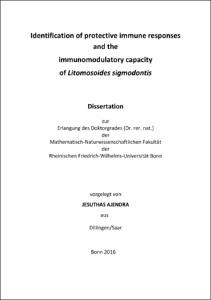Ajendra, Jesuthas: Identification of protective immune responses and the immunomodulatory capacity of Litomosoides sigmodontis. - Bonn, 2016. - Dissertation, Rheinische Friedrich-Wilhelms-Universität Bonn.
Online-Ausgabe in bonndoc: https://nbn-resolving.org/urn:nbn:de:hbz:5n-44687
Online-Ausgabe in bonndoc: https://nbn-resolving.org/urn:nbn:de:hbz:5n-44687
@phdthesis{handle:20.500.11811/6879,
urn: https://nbn-resolving.org/urn:nbn:de:hbz:5n-44687,
author = {{Jesuthas Ajendra}},
title = {Identification of protective immune responses and the immunomodulatory capacity of Litomosoides sigmodontis},
school = {Rheinische Friedrich-Wilhelms-Universität Bonn},
year = 2016,
month = nov,
note = {Using the mouse model Litomosoides sigmodontis, research focusing on the protective immune responses within the host as well as the immunomodulatory capabilities of filarial infections is possible. The immunomodulatory capacities of filariae not only allow the worms to persist for a long time within the host, but also mediate a beneficial effect for the host itself, for example by protecting against autoimmune diseases.
In this thesis, a role for the intracellular pattern recognition receptor NOD2 during infection with Litomosoides sigmodontis is demonstrated. NOD2 deficient mice had an increased worm burden at the site of infection compared to wild type (WT) controls during the early phase of infection. While the immune response within the thoracic cavity, the site of adult worm residence, was not impaired, subcutaneous injection of L3 larvae did not lead to an increased worm burden in NOD2-/- mice. This thesis reveals that the NOD2-dependent mechanism occurs within the skin. We found an impaired neutrophil recruitment to the skin against invading L3 larvae as the decisive mechanism leading to the increased worm burden in NOD2-/- mice. A new role for the NOD2 receptor during the skin stage of L. sigmodontis infection is shown. The essential role for neutrophils during protective immune responses within the skin was further confirmed using IL-6-/- mice, in which the increased worm burden during early time points of infection was also found to be caused by an impaired neutrophil recruitment to the skin.
Another focus of this thesis was the immunomodulatory abilities of helminth infections on autoimmune diseases. Intraperitoneal injections of a crude worm extract in combination with intra-nasal proinsulin administration prevented the onset of type 1 diabetes in non-obese diabetic (NOD) mice. While each component by itself was not successful when given at a progressed state of disease, our combination therapy protected mice until the age of ten weeks; a time point in NOD mice at which insulitis of the pancreatic islet cells already occurs Our study demonstrates that the inclusion of an antigen-specific treatment to the already known protective effect of helminth antigens improves the protection against type 1 diabetes onset.},
url = {https://hdl.handle.net/20.500.11811/6879}
}
urn: https://nbn-resolving.org/urn:nbn:de:hbz:5n-44687,
author = {{Jesuthas Ajendra}},
title = {Identification of protective immune responses and the immunomodulatory capacity of Litomosoides sigmodontis},
school = {Rheinische Friedrich-Wilhelms-Universität Bonn},
year = 2016,
month = nov,
note = {Using the mouse model Litomosoides sigmodontis, research focusing on the protective immune responses within the host as well as the immunomodulatory capabilities of filarial infections is possible. The immunomodulatory capacities of filariae not only allow the worms to persist for a long time within the host, but also mediate a beneficial effect for the host itself, for example by protecting against autoimmune diseases.
In this thesis, a role for the intracellular pattern recognition receptor NOD2 during infection with Litomosoides sigmodontis is demonstrated. NOD2 deficient mice had an increased worm burden at the site of infection compared to wild type (WT) controls during the early phase of infection. While the immune response within the thoracic cavity, the site of adult worm residence, was not impaired, subcutaneous injection of L3 larvae did not lead to an increased worm burden in NOD2-/- mice. This thesis reveals that the NOD2-dependent mechanism occurs within the skin. We found an impaired neutrophil recruitment to the skin against invading L3 larvae as the decisive mechanism leading to the increased worm burden in NOD2-/- mice. A new role for the NOD2 receptor during the skin stage of L. sigmodontis infection is shown. The essential role for neutrophils during protective immune responses within the skin was further confirmed using IL-6-/- mice, in which the increased worm burden during early time points of infection was also found to be caused by an impaired neutrophil recruitment to the skin.
Another focus of this thesis was the immunomodulatory abilities of helminth infections on autoimmune diseases. Intraperitoneal injections of a crude worm extract in combination with intra-nasal proinsulin administration prevented the onset of type 1 diabetes in non-obese diabetic (NOD) mice. While each component by itself was not successful when given at a progressed state of disease, our combination therapy protected mice until the age of ten weeks; a time point in NOD mice at which insulitis of the pancreatic islet cells already occurs Our study demonstrates that the inclusion of an antigen-specific treatment to the already known protective effect of helminth antigens improves the protection against type 1 diabetes onset.},
url = {https://hdl.handle.net/20.500.11811/6879}
}






